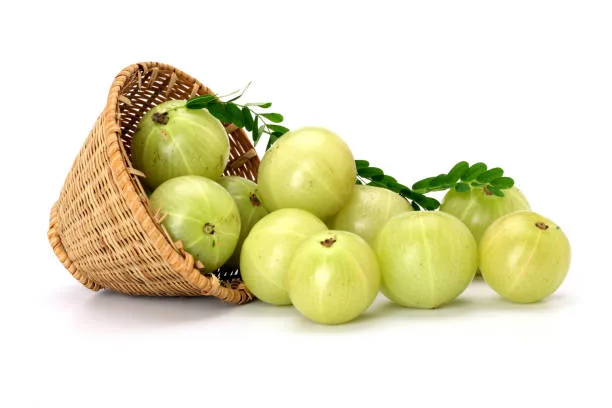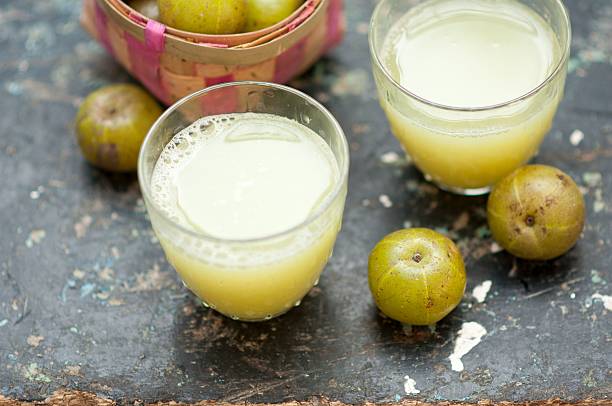Amla-Indian Gooseberry: A Gift to Ayurveda-2023
Amla –
Introduction
Amla is frequently referred to as an Indian gooseberry. Because of the berry’s significant medicinal qualities, they are frequently employed in pharmaceutical compositions. Round, yellowish-green, tiny berries that are found on amla trees. It ought to be recognized to as a superfood due to its numerous health advantages. Amla is referred to by a variety of names in classical Ayurveda, including mother, nursing, sour, and immortality.
It is native to the subtropical South Asian countries of India, Pakistan, and Bangladesh. Amla is grown in tropical desert areas of India and is commercially produced in northern India.

Amla
It has five distinct flavours, including pungent, astringent, sweet, bitter, and sour. In addition to this, it promotes greater physical and mental wellness. Because of this, it is referred to as a “divine medicine,” or “Divyaushada.” Sanskrit refers to it as amalaki, which translates to “nectar of life.”
It’s one distinctive flavor trait is full of five distinct
The Indian Gooseberry tree is Small to medium in size; it can grow to a height of 1 to 8 m. It is 10–20 cm long, finely pubescent (as opposed to glabrous), and typically has deciduous branchlets.
Simple, subsessile, light green leaves that resemble pinnate leaves are tightly spaced along branchlets.
Greenish-yellow blooms can be seen. The fruit has six vertical stripes, or furrows and is almost spherical in shape. It is pale greenish-yellow in colour, fairly smooth, and hard to the eye.
Cultivated fruits weigh between 28.4 and 28.4 g on average, as opposed to the 5.5 g that the fruit of wild plants weighs.

Chemical Analysis
Indian gooseberry contains a lot of different antioxidants. The ability of antioxidants to scavenge free radicals produced by the body when under stress is well documented. Amla has a significant potassium content in addition to being an antioxidant.
As a result, patients with blood pressure issues frequently include potassium in their diets because of its potential to control blood pressure. Potassium’s main method of controlling hypertension is widening blood arteries, which further lowers the likelihood of blood pressure. Amla(Indian Gooseberry) juice consumption in this case might be beneficial.

These fruits have a bitter flavor that may be caused by a high density of ellagitannins, including emblicanin A (37%), emblicanin B (33%), punigluconin (12%), and pedunculagin (14%), as well as high levels of ascorbic acid vitamin. Amla(Indian Gooseberry) also contains flavonoids, kaempferol, ellagic acid, and gallic acid, as well as punicafolin and phyllanemblinin A.
It is one of the best sources of vitamin C found in nature, with fresh juice having roughly twenty times as much as orange juice. The vitamin C content of just one little fruit is equal to that of two oranges. This high concentration is absorbed more quickly than the synthetic vitamin, according to clinical trials on pulmonary tuberculosis patients.
Uses of Indian Gooseberry

Indian gooseberry is traditionally used as a natural treatment to manage or control diabetes. Stress-related disorders are the primary cause of diabetes. Vitamin C is abundant in amla. It is an effective antioxidant that will aid in counteracting the production of free radicals and the effects of oxidative stress.
Regular intake of goods containing amla can lower your risk of developing diabetes. The fiber’s in amla can assist in absorbing extra sugar in the body to maintain normal blood sugar levels through a different process. Almonds can thus aid in the proper treatment of diabetes if you include them in your diabetes diet plan.
It can aid in the body’s natural detoxification process during the menstrual cycle and help to keep hormone levels balanced, both of which will increase a woman’s fertility.
It is a natural blood purifier and can make the skin glow when consumed regularly. Amla (Indian gooseberry) products can also aid in the treatment of certain skin allergies.
What benefits does Indian Gooseberry offer?
Delays Ageing. Amla is rich in vitamin C, which acts as a potent antioxidant.
It helps with weight loss.
Reduces Cholesterol.
Fights colds and coughs.
Prevents Constipation.
Regulates blood sugar.
Boosts Immunity.
Strengthens Bones.
What function does Indian gooseberry serve in daily life?
Daily consumption of amla aids in the treatment of a number of underlying conditions, including infertility, digestive problems, colds, coughs, and allergies, to name a few. Aside from that, amla has remarkable anti-inflammatory and anti-cancer qualities, thus consuming it raw or as juice can naturally treat a number of health problems.
Can we apply Indian gooseberry to the face?
Amla contains antioxidants and vitamin C, which help to lighten the skin. It helps lighten dark spots and hyperpigmentation while overall evening out skin tone. Amla promotes faster cell turnover, which results in clearer, healthier skin. It’s one of the top advantages of amla for the skin.
When can we eat Indian gooseberries?
Have amla every morning on an empty stomach for the greatest effect. You may have 1-2 amla fruits every morning. Eat no more than two because it contains a lot of vitamin C and could cause constipation. Additionally, make an effort to stay hydrated throughout the day.




